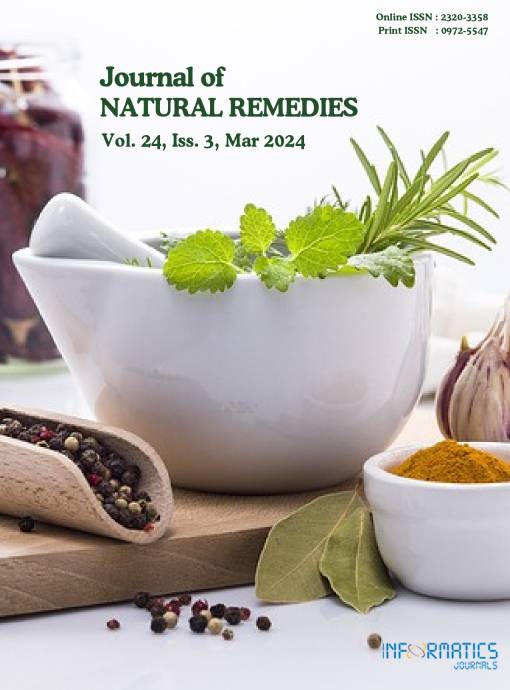Ethno-Medico-Botanical Studies of Plant Resources of Beed District, Maharashtra, India: Retrospect and Prospects
DOI:
https://doi.org/10.18311/jnr/2024/35654Keywords:
Beed District, Ethnobotany, Medicinal Plants, Traditional Healing Practices, Therapeutic PotentialAbstract
The Beed district of Maharashtra, India, harbors a rich repository of ethnobotanical knowledge regarding medicinal plants. This review delves into the traditional wisdom of local communities, documenting the therapeutic applications of 191 plant species belonging to 61 families. The study reveals a diverse array of medicinal remedies derived from various plant parts, with leaves being the most commonly utilized. Skin diseases, gastrointestinal disorders, respiratory infections, and fever emerged as the primary ailments treated with these plant-based remedies. This comprehensive review underscores the urgent need for further ethnobotanical exploration within the district to meticulously document the traditional knowledge associated with medicinal plants and rigorously validate their efficacy through scientific investigation. Delving into the secrets of these medicinal plants might unveil a wealth of novel herbal remedies, all while protecting these invaluable natural treasures.
Downloads
Metrics
Downloads
Published
How to Cite
Issue
Section
License
Copyright (c) 2024 Amar Bhumbe, Vinod Devarkar (Author)

This work is licensed under a Creative Commons Attribution 4.0 International License.
Accepted 2024-01-16
Published 2024-03-01
References
Pushpangadan P, George V, Ijinu TP, Rajasekharan S. Ethnobotany, ethnobiology, ethnopharmacology, bioprospecting of traditional knowledge and evolution of benefit sharing. Indian ethnobotany: emerging trends. The Scientific Publisher, Jodhpur. 2016. p. 1-23.
Reyes-García V. The relevance of traditional knowledge systems for ethnopharmacological research: theoretical and methodological contributions. Journal of Ethnobiology and Ethnomedicine. 2010; 6(1):1-2. https://doi.org/10.1186/1746-4269-6-32
Baker JT, Borris RP, Carté B, Cordell GA, Soejarto DD, Cragg GM, et al. Natural product drug discovery and development: new perspectives on international collaboration. Journal of Natural Products. 1995; 58(9):1325–57. https://doi.org/10.1021/np50123a003
Dhore M, Dabhadkar D, Zade V, Dhore M. Documentation of fertility regulatory ethnomedicinal plants used by tribal’s of Yavatmal District, Maharashtra, India. Population. 2001. p. 2-460.
Jagtap SD, Deokule SS, Pawar PK, Harsulkar AM. Traditional ethnomedicinal knowledge is confined to the Pawra tribe of Satpura Hills, Maharashtra, India. Ethnobotanical Leaflets. 2009; 1:12.
Mali PR. Ethnobotanical studies of Peth and Trimbakeshwar district Nashik, Maharashtra, India. Trends Life Sci. 2012; 1:35-7.
Shaikh RU, Dukare DD, Sarwade KP, Sarwade PP. Ethnobotanical study of folk medicinal plants used by villagers in Nanded district of Maharashtra (India). International Journal of Ayurvedic and Herbal Medicine. 2014; 4(5):1585-95.
Patil MB, Khan PA, Shaikh M. Ethno ecological knowledge and medicinal flora from South-Western Satpuda, Maharashtra. Life Sciences Leaflet. 2015; 63:44-56.
Shinde YP, Arangale KB, Bhalerao VU. Ethnobotanical survey of Kopargaon Tehsil of Maharashtra. World Journal of Pharmaceutical Research. 2017; 6(14):786-92.
Chute S, Dakhane V. Ethnobotanical studies of wild vegetable used by gond tribe of Lakhani Taluka, Bhandara District, Maharastra State, India. International Journal of Research in Biosciences, Agriculture and Technology Issue. 2022.
Jaju BN, Choudhari PB. Ethnobotanical study of Beed District of Maharashtra, India. International Journal of Pharmacy and Pharmaceutical Sciences. 2014; 6(3):833-40
Salave J, Reddy KN. Ethnobotanical study of medicinal plants used by tribals against asthma in Beed district of Maharashtra, India. International Journal of Pharmacy and Pharmaceutical Sciences. 2012; 4(2):469-73.
Mandale AB, Mane VS, Kendre SB. Ethnobotanical study of medicinal plants used by tribals in Beed district of Maharashtra, India, for the treatment of skin diseases. Journal of Ethnopharmacology. 2019; 231:206-29.
Dhamak AS, Meshram BR, Mandale AB. Floristic diversity of Beed district of Maharashtra. International Journal of Scientific and Research Publications. 2014; 4(12):1-28
Mandale AB, Mane VS, Kendre SB. Ethnobotanical study of medicinal plants used by tribals in Beed district of Maharashtra, India, for the treatment of skin diseases. Journal of Ethnopharmacology. 2019; 231:206-29.
Jeph SA, Khan SH. Rare, Endemic, Endangered, and Threatened (RET) medicinal plants of Beed district, Maharashtra, India. Journal of Threatened Taxa. 2019; 11(12):14886-96.
Xu J, Ma ET, Tashi D, Fu Y, Lu Z, Melick D. Integrating sacred knowledge for conservation: cultures and landscapes in southwest China. Ecology and Society. 2005; 10(2). https://doi.org/10.5751/ES-01413-100207
Gilani AH. Trends in ethnopharmacology. Journal of Ethnopharmacology. 2005; 100(1-2):43-9. https://doi.org/10.1016/j.jep.2005.06.001
Cordell GA. Biodiversity and drug discovery - a symbiotic relationship. Photochemistry. 2000; 55(6):463–80. https://doi.org/10.1016/S0031-9422(00)00230-2

 Amar Bhumbe
Amar Bhumbe









 0.35
0.35 24
24 0.161
0.161